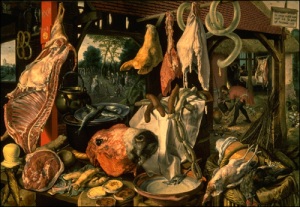
A Meat Stall with the Holy Family Giving Alms Aertsen, Pieter (1551); North Carolina Museum of Art, Raleigh, NC, USA
Persistent in interpretation of the medieval and renaissance periods is the story that heavy amounts of spice were used to disguise the taste of rotten or spoiled meat. But, is this a historic practice or a conclusion erroneously drawn from varied sources?
The desired spice palate of receipts (recipes) found in primary source documents might offend the modern taste. Elias Ashmole, the 17th century antiquarian, documented a 15th century recipe for Stewed Beef Ribs which calls for cinnamon, cloves, mace, grains of paradise, black pepper, onions, parlsey, sage, saffron, salt, and vinegar in the seasoning of the meat:
Beef y-Stywyd. Take fayre beef of þe rybbys of þe fore quarterys, an smyte in fayre pecys, an wasche þe beef in-to a fayre potte; þan take þe water þat þe beef was soþin yn, an strayne it þorw a straynowr, an sethe þe same water and beef in a potte, an let hem boyle to-gederys; þan take canel, clowes, maces, graynys of parise, quibibes, and oynons y-mynced, perceli, an sawge, an caste þer-to, an let hem boyle to-gederys; an þan take a lof of brede, an stepe it with brothe an venegre, an þan draw it þorw a straynoure, and let it be stylle; an whan it is nere y-now, caste þe lycour þer-to, but nowt to moche, an þan let boyle onys, an cast safroun þer-to a quantyte; þan take salt an venegre, and cast þer-to, an loke þat it be poynaunt y-now, & serue forth.
Certainly a fair amount of spices. But, are we to assume from the recipe this is because the cook expected the meat to be rancid in taste?
The parsley and onions would be readily available to any cook in England from their own kitchen gardens and sage, though originally native to the Mediterranean, could be cultivated as well. The other spices the recipe needs begin to form an answer for us: cinnamon was imported by sea from Sri Lanka; cloves by sea trade from southeast Asia; mace, from the husks of nutmeg, arrived by sea from Indonesia; grains of paradise from West Africa; black pepper from India; and saffron, still amongst the most expensive spices at today’s supermarket, is native to Southwest Asia.
With so many rare, imported spices wealth was a factor in the use of a wide variety of them in any meat recipe. Why then should we assume that a wealthy table, which can afford so many luxury spices, should be willing to accept rancid or spoiled meat?
The answer becomes clearer when we examine a recipe for a vegetable dish of the period. A contemporary receipt for peas-porridge demonstrates that the vegetable dishes were spiced as heavily as meat dishes, calling for a combination of parlsey, thyme, mint, sage, basil, onions, saffron, cinnamon, nutmeg, cloves, and cardamom. While the fresh herbs would again be available in many kitchen gardens, the expensive imported spices would not be in wide use.
C. Anne Wilson, in her book Food and Drink in Britain: From the Stone Age o the 19th Century, concurs stating “… for the gentry fresh meat, newly slaughtered on the manor farm, was in fact available through much of the year, while poultry was never killed until it was needed for the table… palates were accustomed to strong aromatic flavours, unspiced foods tasted insipid.”
Why then do historic sites, interpreters, and teachers repeat the story of heavily spiced, rancid meat? The source for the misconception seems to be The Englishman’s Food: Five Centuries of English Diet by J.C. Drummond published in 1939. In his work, Drummond surmises that the heavily spiced recipes of the period must be a method for making tainted meat edible by concluding that “the popularity of strong seasoning for meat was undoubtedly due to the frequency with which it was necessary to mask taint.” Drummond’s assumptions have provided a misconception of period cooking and the use of spices in meat dishes. The repetition of this conclusion has created a food myth with which the history teacher, historic site, and interpreter must deal.

Thank you! I’ve been trying to tell people this for years!
i always thought it was very odd to hear people INSIST that someone had so little sense as to waste spices (more expensive than gold some of them) on bad meat.
especially since there were so many known ways to preserve it.
we may not like “meat preserved in wine” but picked meats worked… so do salt meats, and of course the northern countries had cold winters, the southern countries just kept some of the livestock around “as needed” etc.
well I agree and disagree, a poor farmer, with just his small family to feed, upon slaughtering anything larger than a chicken might be hard-pressed to eat it all when fresh and would be very hesitant to toss the tainted flesh. And without the bland diet of corn for everyone and everything that modern farming provides, meat may have been rather gamey regardless of it’s freshness. I don’t like the idea that if you can’t research it, it didn’t happen.
The problem would be that a poor farmer could not afford the spices needed to make it true. They were, quite literally, worth their weight in gold.